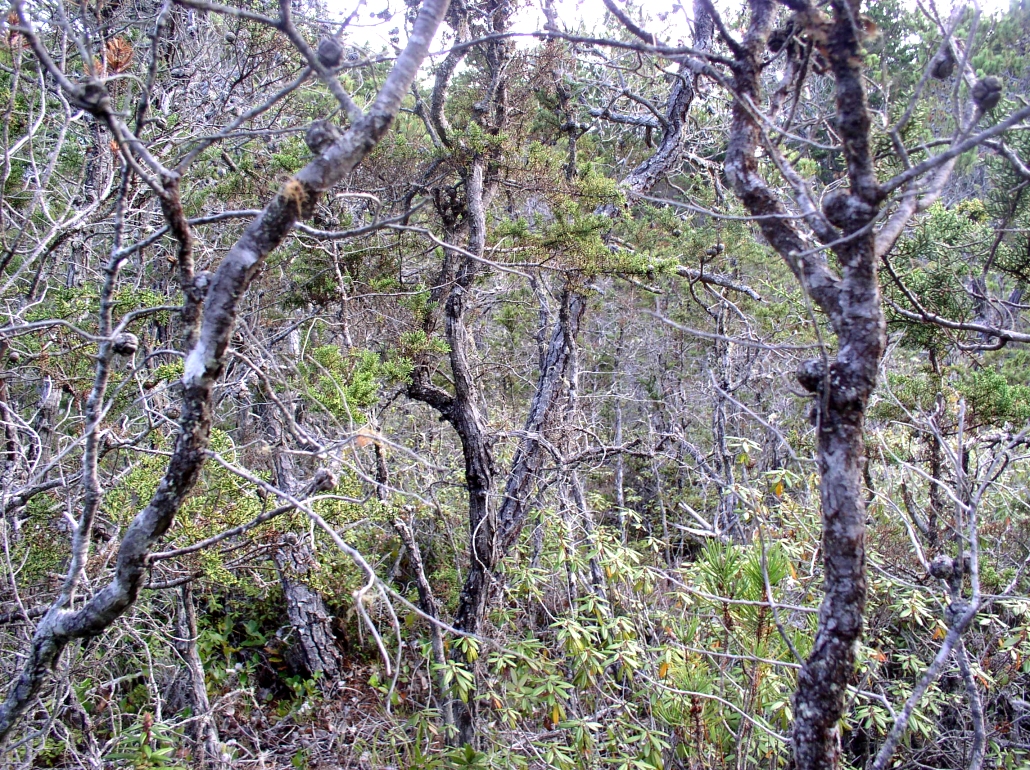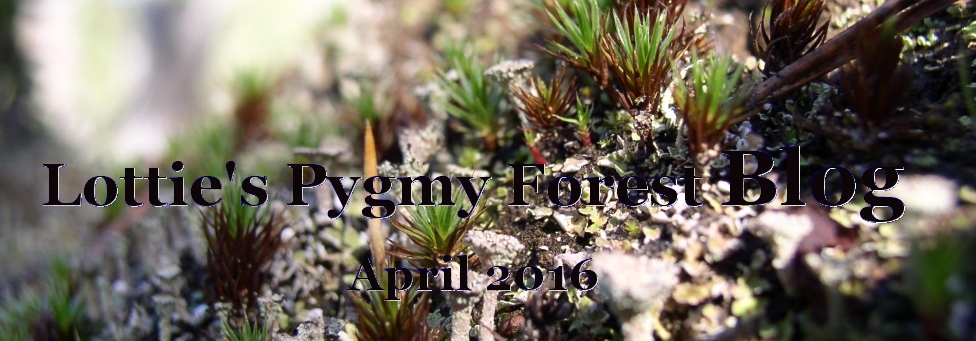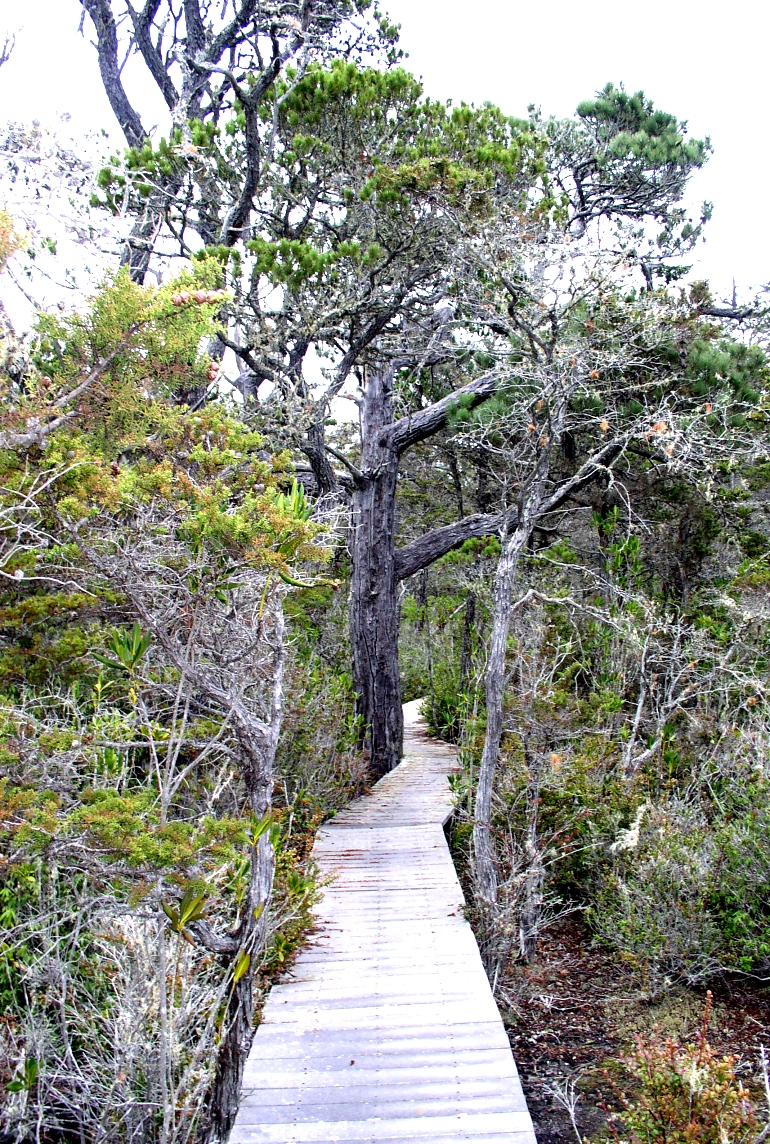
|

Would You Let Your Child Play In The Pygmy Forest?
The pygmy forest has been known to trigger the type of alarm response in people that can make one's heart race, palms sweat, hands shake and breathing quicken. Cool, calm and confident men and women have stepped just a few yards into the cypress thickets and Labrador tea-stalk brambles, then lost all sense of reason and orientation. Scientists who have long studied the pygmy forest believe that the best way to approach the the pygmy is with a scientific mindset but even they are at a loss to explain some of what they have discovered there. The pygmy forest tends to draw people in like rubber-neckers who can't look away from a wreck on the side of the road. People get lost in the pygmy forest.
I have been traipsing in and through the pygmy forest for the better part of 50 years and I've read much of what has been written, but I can not yet characterize it's nature in a clear and concise manner. It is true that the trees and shrubs are short and twisted. That is why it's called the pygmy forest. Much there is broken, withered and old before it's time. In the pygmy forest there are no landmarks such as rock outcroppings, streams or other useful points of reference. The view all around confronts the viewer with a visual sort of dissonance that is vaguely like a dream. Even the horizon is missing from view. These are only some of the reasons for navigational malfunctions but they don't quite explain why some people lose more than their bodies in the pygmy forest.

|
Being out in nature is thought of as a fulfilling experience where many people claim to restore their batteries and refresh their outlook on life. This is usually true for me but I can spend an entire week walking through hundreds of acres of pygmy forest, studying every little plant, soil exposure and tea-colored pool, only to return home without an enlightened thought or inspired emotion. My intellect seems to vanish and my inherent connection to nature is suspended after such a week. My burden is a strong desire to understand where I have been. This has resulted in an insatiable curiousity which sometimes teeters on the brink of obsession. The pygmy forest is a really, really, really weird place.
Father and Daughter Lost In Pygmy Forest
Joseph and Carrie Spivack were lost for 12 hours when they went mushroom hunting in the pygmy forest. The rescue involved the Mendocino and Albion fire departments, state forest rangers and the Mendocino search and rescue team. When the father and daughter were found, cold, wet and huddling together in a hollowed out redwood stump in the rain, their rescuers built a fire to warm them, provided dry clothes and fed them warm Gatorade and hot dogs.
Ukiah Daily Journal, Jan. 14, 1993
A 64-year-old Fort Bragg woman who got lost in dense woods while walking her dog Tuesday evening was found unharmed Wednesday morning, according to a Mendocino County Sheriff’s Office press release. The woman, who was not named, was reported missing about 11 pm. Tuesday from her Airport Road residence. According to an MCSO press release,“Deputies searched the area but due to the dense pygmy forest were unable to locate the missing person. On the morning of 5-20-2015 the Mendocino County Sheriff’s Search and Rescue Unit was contacted and responded to the location. ... During the initial search a member of the Mendocino County Sheriff’s Chaplains group overheard someone calling for help in the wooded area near where the missing person was last seen. Search and Rescue members responded to the area. Around 9:08 AM the missing person was found in a very dense area of woods. She was cold and had lost one of her shoes but was otherwise in very good condition. She was assisted out of the area by members of Search and Rescue and Fort Bragg Fire Department.”
Fort Bragg Advocate News, May 21, 2015
I recently talked to one of the members of that search and rescue team about the crisis. He spoke candidly but asked to remain anonymous, so I'll call him Ralph. Ralph has a vivid memory of the day that “that older woman” got lost because he too got lost while looking for her. Ralph remembers feeling helpless and hopelessly embarrassed. So much so, that he decided not to use his 2-way radio to ask for help. He said could hear other team members talking or answering on their radios but he could not determine the distance or direction the sounds were coming from. He told me that he just kept going through thick brush and brambles and trying not to walk in circles. Up to this point in his life, Ralph considered himself a competent outdoorsman and one of the communities problem solvers. To this day the experience has shaken his confidence. Ralph eventually found some of his team members and quietly slipped in among them. He now spends as little time in the pygmy forest as he can.
| Three minutes of a frog serenaded walk through the pygmy forest. |
There are few animals to be found in the pygmy forest. Occasionally deer may walk through, but they will not stop to browse or sleep there and only rarely is birdsong heard. The nearby regular forests abound with raccoons, bobcats, deer, rats, moles and other familiar animals but they seem to avoid the pygmy forest. The natural instincts of dogs sometimes fail in pygmy forests as a local family discovered one terrible day, which lasted for over a month.
Richard and Susan Strom own the Whitegate Inn and Abigail's Bed & Breakfast in Mendocino. They have a Portuguese Water Dog named Corkey. On November 3rd, 2003, Richard Strom was hiking with Corkey, in Van Damme State Park (Van Damme State Park is well known for it's world famous Pygmy Forest Discovery Trail.)near Little River, Calif. when Corkey ran off the trail, into the pygmy forest and just seemed to disappear. After calling and searching, Richard left briefly, and returned with his wife Susan to continue the search. By the time it became dark, they had enlisted their entire staff to look for Corkey. After hours of searching everyone was just baffled because it was so unlike Corkey to run off and fail to respond to anyone's calls to return. For the next several weeks searchers walked through the area and posted hundreds of fliers throughout the area. By the beginning of December, Corkey had been missing for a month and the weather was turning cold and wet. Richard and Susan began to lose hope of ever seeing Corkey again. Then, on December 16, an area resident saw a skinny bedraggled dog run across the highway about 3 miles from the pygmy forest. Like most living in the area, the man had heard about Richard and Susan's missing pet. He called out to Corkey by name and the dog ran toward him, then jumped into his car. When Corkey was finally returned to his owner he had lost 29 pounds,was covered with over 300 ticks and was otherwise healthy and happy to be home. The story of this miraculous reunion was covered in newspapers throughout the nation and became a chapter in the book, "Four-Legged Miracles: Heartwarming Tales of Lost Dogs' Journeys Home" By Brad & Sherry Hansen Steiger.
|
Pedicularis densiflora, known commonly as Indian warrior or warrior's plume, is a plant of the louse-wort genus in the broomrape family. Native to California and Oregon it is found in chaparral, forests and California oak woodlands at low elevations. It can be found in the pygmy forest in early spring . Pedicularis densiflora is a perennial herb with stout, green or reddish stems, fern-shaped leaves, and long spikes of deep red to bright pink flowers with toothed petals. Like others of its genus, it is a hemiparasite plant, attaching to the roots of other plants to obtain nutrients and water. It can live without attaching to another plant but will parasitize if presented with the opportunity and may attach it's roots to manzanita plants. The flowers are used by some as a tea or mixed with other herbs and smoked for it's supposed relaxing qualities. |
|
These are just a couple of examples of people losing their pets or themselves in the pygmy forest and such stories seem to be repeated year after year in the local news, with an infinite number of slight variations. Getting lost is only a part of the pygmy forest lore for people have lost their mates and even their minds amidst the eye-level canopy of gray lichen-hung branches and spindley cypress stalks.
What follows is a poem called "Pygmy Forest Song" by one Kendra Ruczak. I don't know the back story here but this is not a song extolling the wonder and enchantment of the place. Clearly, the pygmy forest, has a desperate or tragic connotation in the heart of the poet:

|
Pygmy Forest Song
|
| Is he lost out there, or did he go away from me? | Copyright © Kendra Ruczak | Year Posted 2015 |
The only work that comes close to characterizing the pygmy forest for me follows in these excerpts from "Staircase Through Time" written by Bruce Fenson, editor of Pacific Discovery, a publication of the California Academy of Sciences. Here he writes about the pygmy forest on the highest step of the "Ecological Staircase", a series of five sequential marine terraces along the coast of Mendocino County.
"The pygmy forest is an unsettling place to visit. It certainly does not look like a forest. Nor does it appear like a copse of saplings, small though the trees may be. The place has it's own distinctive, somewhat eerie atmosphere. The majority of the trees are no more than five or six feet tall, over-topped here and there by an occasional forest giant of ten or twelve feet. In some sections of the forest the trees are no more than knee high. Yet they are fully mature trees, with cones and catkins hanging from their limbs. Their trunks and branches are gnarled and twisted, their bark split and weathered and half hidden beneath lichens of many shapes and colors, their branches misty with hanging moss. These trees look old, worn, mysterious. Their ancient aspect, together with their diminutive size, gives the walker in these woods the feeling of having stepped through a dimensional discontinuity, and come out among the primal wilderness of a radically smaller world.
"Although the pygmy is a quiet place, it is not at all gentle or restful. The trees are stiff-branched, and look as if they would stand tensely against any breeze. The ground is hard, sparsely covered with mosses, streaked whitely with mineral salts. There is little of obvious aesthetic appeal here. One does not wander blithely through these woods or rest quietly beneath the boles.
"One stands and wonders, and feels the strangeness of all things. As with many more-or-less barren places, it is easy, here, to wonder not only how this forest came to be but how anything organic comes to be in the midst of the deathly mineral world. To stand in such a place and look about is like suddenly discovering oneself at the furthest edge of life, having been unaccountably granted a rare opportunity to look beyond."
It turns out that there are at least two pygmy forests which occupy the same spaces. There is the actual physical pygmy forest that we can see and explore together and then there is a pygmy forest that must reside in the imagination and probably the heart as well. I know this because of the number of bad reviews on outdoor ratings websites like Tripadvisor.com. Many of the comments by first time pygmy forest visitors express a feeling of significant disappointment. Someday soon I will explore the great disparity between what people imagine about the pygmy forest and what they find when they see it for the first time.
A "Rediscovering Charlotte M. Hoak Pygmy Forest" event is set to take place on September 10,
2016.